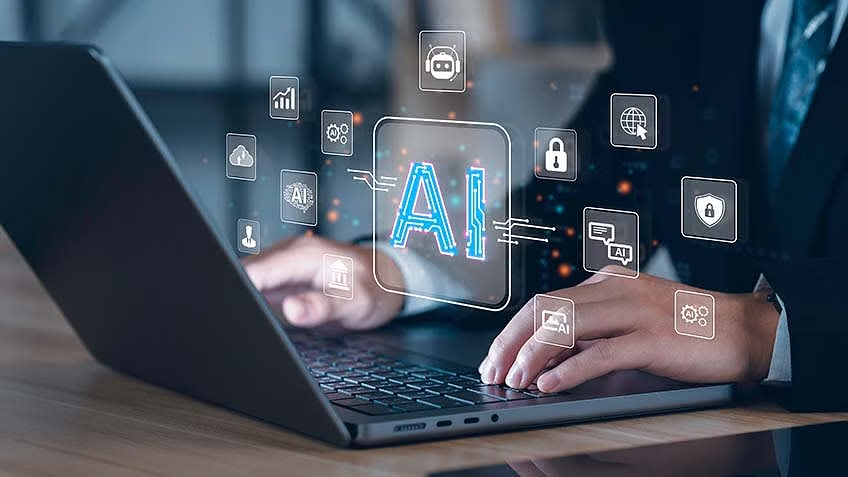Introduction to AI for Business Productivity
Artificial Intelligence (AI) refers to the simulation of human intelligence processes by computer systems and machines. AI has advanced rapidly in recent years, enabling technologies that can perceive, learn, reason, and assist or automate human tasks. From automating repetitive processes to providing data-driven insights, AI offers powerful capabilities to boost productivity and efficiency for businesses.
While overall AI adoption remains steady at around 55 percent, more companies are exploring and implementing AI solutions. A recent survey found 77% of companies are either using or actively exploring AI to augment their operations and workflows.
AI for Automating Repetitive Tasks
One of the most impactful applications of AI for boosting business productivity is through automating repetitive, mundane tasks. Robotic process automation (RPA) powered by AI can streamline data entry, reporting, invoicing, scheduling, and other routine workflows. For example, AI tools like ChatGPT can automatically generate reports and documents based on data inputs, freeing up employees’ time for higher-value work.
AI can parse through large volumes of structured and unstructured data to extract relevant information and populate forms, databases, and other systems automatically. This eliminates error-prone manual data entry while accelerating processes. AI-driven invoice processing can read invoices, validate information against purchase orders and contracts, route approvals, and trigger payments – dramatically reducing invoice handling time and costs.
AI scheduling assistants can optimize employee schedules based on availability, workloads, skills, and other factors. They can also intelligently manage calendars, arrange meetings accounting for time zones and participants’ preferences, and handle rescheduling with minimal disruption. By handling these routine yet vital tasks, AI automation tools allow businesses to operate more efficiently while giving employees more time to focus on strategic and creative work.
AI Virtual Assistants and Chatbots
AI-powered virtual assistants and chatbots offer a powerful way for businesses to automate customer service and query handling. These conversational AI tools can understand natural language, provide instant responses to common questions, and handle tasks like booking appointments or scheduling meetings 24/7 without human intervention. According to IBM, chatbots can generate leads, encourage conversions, and cross-sell products by engaging website visitors and guiding them through the sales process.
By offloading routine customer inquiries to AI chatbots, businesses can reduce wait times, improve responsiveness, and free up human agents to focus on more complex issues that require a personal touch. AI virtual assistants act as always-available touchpoints, providing customers with convenient self-service options while capturing valuable data that can inform product development and customer experience strategies.
AI Data Analysis and Predictive Analytics
One of the most powerful applications of AI for businesses is its ability to analyze vast amounts of data and uncover valuable insights that can drive strategic decisions. By leveraging machine learning algorithms and predictive modeling, AI can identify patterns, trends, and correlations that would be nearly impossible for humans to detect manually. This data-driven approach enables businesses to make more informed choices, optimize operations, and gain a competitive edge.
AI excels at processing structured and unstructured data from various sources, such as sales records, customer interactions, market trends, and social media sentiment. By combining this data with advanced analytics techniques, AI can generate accurate forecasts, anticipate future demand, and recommend actions to maximize profitability or minimize risks. For example, Google Cloud’s generative AI use cases showcase how companies are leveraging AI to predict equipment failures, optimize supply chains, and personalize product recommendations.
Moreover, AI can continuously learn and adapt its models as new data becomes available, ensuring that the insights and recommendations remain relevant and up-to-date. This real-time intelligence empowers businesses to respond swiftly to changing market conditions, customer preferences, and operational challenges, ultimately driving greater efficiency, innovation, and growth.
AI for Marketing Automation
AI is revolutionizing marketing automation, enabling businesses to streamline lead generation, personalize campaigns, and gain valuable insights. Tools like Sprout Social’s AI Content Planner leverage machine learning to analyze audience data and trends, suggesting the ideal times, channels, and content themes to maximize engagement. Email marketing platforms like Mailchimp’s AI Content Optimizer use AI to craft subject lines, copy, and visuals tailored to each recipient’s preferences.
Beyond email, AI powers website personalization engines that dynamically serve up content and offers based on a visitor’s behavior and demographics. And on the analytics side, AI-driven insights tools can comb through vast datasets to surface patterns, predict trends, and recommend data-backed strategies. By automating repetitive tasks and leveraging machine learning’s predictive power, AI allows marketers to operate more efficiently while delivering more relevant, impactful campaigns.
AI Communication and Collaboration Tools
AI is revolutionizing team communication and collaboration through intelligent tools that boost productivity. Meeting transcription software powered by AI can automatically capture notes, action items, and key decisions during discussions, freeing participants to be fully present. Tools like AskLucy create a searchable knowledge base from meeting recordings.
AI email assistants can draft replies, summarize conversations, schedule meetings, and surface relevant information based on context. They learn an individual’s writing style and automate tedious email management tasks. For document creation, AI writing aids can generate first drafts, provide content suggestions, and improve writing quality through natural language processing.
AI-driven collaboration platforms consolidate team messaging, file sharing, task management, and real-time co-editing in a unified workspace. They leverage AI to surface relevant information, automate workflows, and facilitate seamless asynchronous collaboration across teams and time zones. Overall, AI enhances communication efficiency while fostering greater transparency and knowledge sharing.
Augmenting Human Capabilities with AI
While AI can automate many repetitive tasks, its true power lies in augmenting human intelligence and capabilities. By leveraging AI for data analysis and insight generation, businesses can uncover patterns, trends, and opportunities that would be difficult for humans to detect on their own. AI can provide intelligent recommendations based on vast amounts of data, guiding decision-making and strategic planning.
For example, AI systems can analyze customer data, market trends, and competitor activities to recommend optimal pricing strategies, product offerings, and marketing campaigns tailored to specific segments or regions. In sales, AI can prioritize leads and suggest personalized outreach approaches based on historical data and buyer behavior patterns. AI-powered recommendation engines can suggest relevant content, products, or services to customers, enhancing their experience and driving engagement (Source).
By augmenting human capabilities with AI insights and recommendations, businesses can make more informed decisions, optimize operations, and gain a competitive edge. However, it’s crucial to strike a balance, leveraging AI as a powerful tool to enhance human judgment and expertise rather than relying solely on automated decision-making.
Strategies for Successful AI Implementation
Integrating AI into business processes requires a strategic and well-governed approach. According to CIO, best practices include establishing a clear AI strategy, creating an AI governance committee, developing comprehensive AI policies, and implementing rigorous quality control measures.
It’s advisable to start small by implementing AI in a single domain or process, ensuring it demonstrates a positive return on investment and meets business objectives before expanding to other areas (Forbes). Gaining employee buy-in and addressing concerns through education and training is also crucial for successful AI adoption.
Data quality is a key consideration, as AI models are only as accurate as the data they are trained on. Establishing data governance policies and ensuring data is clean, unbiased, and representative is essential. Additionally, ethical considerations such as privacy, transparency, and accountability must be factored into AI implementation to mitigate risks and build trust.
AI Productivity Case Studies
Leading companies are already realizing significant productivity gains from implementing AI in their operations. A McKinsey study (link) estimated the long-term opportunity for corporate AI use cases at $4.4 trillion in added productivity growth potential.
Goldman Sachs research (link) found that companies adopting AI are seeing an average 25% increase in productivity, with large efficiency gains across various industries. For example, JP Morgan used AI to automate loan operations, boosting productivity by 300%. Walmart utilized AI for inventory optimization and labor scheduling, reducing costs by billions.
Generative AI alone is projected to spur up to $1 trillion in annual U.S. economic growth and a 3.5% productivity gain by 2032, according to Cognizant research cited by CFO Dive (link). Early adopters like Microsoft, Google, and OpenAI are already leveraging generative AI models for code generation, content creation, and knowledge work acceleration.
The Future of AI for Business Productivity
As AI technology continues to advance, its impact on business productivity is poised to grow exponentially. Emerging AI capabilities like generative AI models and large language models will enable new levels of human-AI collaboration, augmenting human knowledge workers with intelligent assistants. According to a McKinsey study, generative AI has the potential to increase US labor productivity by 0.5 to 0.9 percentage points annually through 2030 with widespread adoption.
However, the future impact of AI on jobs remains an open question. While AI will likely automate many routine tasks, leading to job displacement in some sectors, it will also create new types of human-AI partnership roles. The key will be to focus AI on augmenting and enhancing human capabilities rather than fully automating human roles. As Forbes notes, AI should be used to offload repetitive tasks so human workers can focus on strategic, creative, and interpersonal aspects of their roles.



